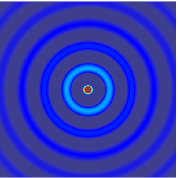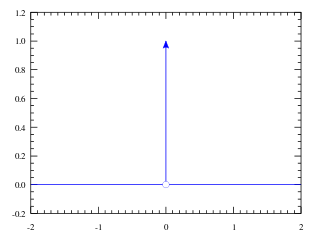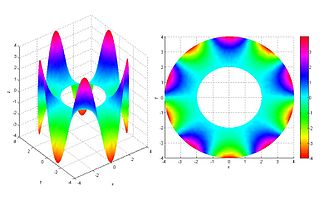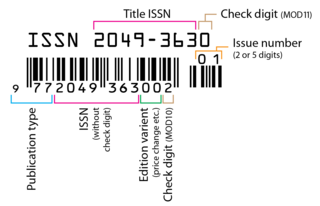
The wave equation is an important second-order linear partial differential equation for the description of waves—as they occur in classical physics—such as mechanical waves or light waves. It arises in fields like acoustics, electromagnetics, and fluid dynamics.

In mathematics, the Dirac delta function is a generalized function or distribution introduced by the physicist Paul Dirac. It is used to model the density of an idealized point mass or point charge as a function equal to zero everywhere except for zero and whose integral over the entire real line is equal to one. As there is no function that has these properties, the computations made by the theoretical physicists appeared to mathematicians as nonsense until the introduction of distributions by Laurent Schwartz to formalize and validate the computations. As a distribution, the Dirac delta function is a linear functional that maps every function to its value at zero. The Kronecker delta function, which is usually defined on a discrete domain and takes values 0 and 1, is a discrete analog of the Dirac delta function.

The Fourier transform (FT) decomposes a function of time into its constituent frequencies. This is similar to the way a musical chord can be expressed in terms of the volumes and frequencies of its constituent notes. The term Fourier transform refers to both the frequency domain representation and the mathematical operation that associates the frequency domain representation to a function of time. The Fourier transform of a function of time is itself a complex-valued function of frequency, whose magnitude component represents the amount of that frequency present in the original function, and whose complex argument is the phase offset of the basic sinusoid in that frequency. The Fourier transform is not limited to functions of time, but the domain of the original function is commonly referred to as the time domain. There is also an inverse Fourier transform that mathematically synthesizes the original function from its frequency domain representation.

The heat equation is a parabolic partial differential equation that describes the distribution of heat in a given region over time.
In mathematics, the Laplace operator or Laplacian is a differential operator given by the divergence of the gradient of a function on Euclidean space. It is usually denoted by the symbols ∇·∇, ∇2, or Δ. The Laplacian Δf(p) of a function f at a point p, is the rate at which the average value of f over spheres centered at p deviates from f(p) as the radius of the sphere grows. In a Cartesian coordinate system, the Laplacian is given by the sum of second partial derivatives of the function with respect to each independent variable. In other coordinate systems such as cylindrical and spherical coordinates, the Laplacian also has a useful form.

In the theory of partial differential equations, elliptic operators are differential operators that generalize the Laplace operator. They are defined by the condition that the coefficients of the highest-order derivatives be positive, which implies the key property that the principal symbol is invertible, or equivalently that there are no real characteristic directions.
Second order linear partial differential equations (PDEs) are classified as either elliptic, hyperbolic, or parabolic. Any second order linear PDE in two variables can be written in the form
In mathematics, the method of characteristics is a technique for solving partial differential equations. Typically, it applies to first-order equations, although more generally the method of characteristics is valid for any hyperbolic partial differential equation. The method is to reduce a partial differential equation to a family of ordinary differential equations along which the solution can be integrated from some initial data given on a suitable hypersurface.
In mathematics, the Hamilton–Jacobi equation (HJE) is a necessary condition describing extremal geometry in generalizations of problems from the calculus of variations, and is a special case of the Hamilton–Jacobi–Bellman equation. It is named for William Rowan Hamilton and Carl Gustav Jacob Jacobi.
In mathematical analysis a pseudo-differential operator is an extension of the concept of differential operator. Pseudo-differential operators are used extensively in the theory of partial differential equations and quantum field theory.
In differential geometry, the Laplace operator, named after Pierre-Simon Laplace, can be generalized to operate on functions defined on surfaces in Euclidean space and, more generally, on Riemannian and pseudo-Riemannian manifolds. This more general operator goes by the name Laplace–Beltrami operator, after Laplace and Eugenio Beltrami. Like the Laplacian, the Laplace–Beltrami operator is defined as the divergence of the gradient, and is a linear operator taking functions into functions. The operator can be extended to operate on tensors as the divergence of the covariant derivative. Alternatively, the operator can be generalized to operate on differential forms using the divergence and exterior derivative. The resulting operator is called the Laplace–de Rham operator.
In mathematics, differential rings, differential fields, and differential algebras are rings, fields, and algebras equipped with finitely many derivations, which are unary functions that are linear and satisfy the Leibniz product rule. A natural example of a differential field is the field of rational functions C(t) in one variable, over the complex numbers, where the derivation is the differentiation with respect to t.
In mathematics, constraint counting is counting the number of constraints in order to compare it with the number of variables, parameters, etc. that are free to be determined, the idea being that in most cases the number of independent choices that can be made is the excess of the latter over the former.
In mathematical analysis an oscillatory integral is a type of distribution. Oscillatory integrals make rigorous many arguments that, on a naive level, appear to use divergent integrals. It is possible to represent approximate solution operators for many differential equations as oscillatory integrals.
In mathematics, and more specifically in partial differential equations, Duhamel's principle is a general method for obtaining solutions to inhomogeneous linear evolution equations like the heat equation, wave equation, and vibrating plate equation. It is named after Jean-Marie Duhamel who first applied the principle to the inhomogeneous heat equation that models, for instance, the distribution of heat in a thin plate which is heated from beneath. For linear evolution equations without spatial dependency, such as a harmonic oscillator, Duhamel's principle reduces to the method of variation of parameters technique for solving linear inhomogeneous ordinary differential equations.
In mathematical analysis, Fourier integral operators have become an important tool in the theory of partial differential equations. The class of Fourier integral operators contains differential operators as well as classical integral operators as special cases.
In the mathematical field of partial differential equations, the ultrahyperbolic equation is a partial differential equation for an unknown scalar function u of 2n variables x1, ..., xn, y1, ..., yn of the form
Quantum characteristics are phase-space trajectories that arise in the phase space formulation of quantum mechanics through the Wigner transform of Heisenberg operators of canonical coordinates and momenta. These trajectories obey the Hamilton equations in quantum form and play the role of characteristics in terms of which time-dependent Weyl's symbols of quantum operators can be expressed. In the classical limit, quantum characteristics reduce to classical trajectories. The knowledge of quantum characteristics is equivalent to the knowledge of quantum dynamics.
The system size expansion, also known as van Kampen's expansion or the Ω-expansion, is a technique pioneered by Nico van Kampen used in the analysis of stochastic processes. Specifically, it allows one to find an approximation to the solution of a master equation with nonlinear transition rates. The leading order term of the expansion is given by the linear noise approximation, in which the master equation is approximated by a Fokker–Planck equation with linear coefficients determined by the transition rates and stoichiometry of the system.
In mathematics, the Fuchs relation is a relation between the starting exponents of formal series solutions of certain linear differential equations, so called Fuchsian equations. It is named after Lazarus Immanuel Fuchs.
Duke Mathematical Journal is a peer-reviewed mathematics journal published by Duke University Press. It was established in 1935. The founding editors-in-chief were David Widder, Arthur Coble, and Joseph Miller Thomas. The first issue included a paper by Solomon Lefschetz. Leonard Carlitz served on the editorial board for 35 years, from 1938 to 1973.

In computing, a Digital Object Identifier or DOI is a persistent identifier or handle used to identify objects uniquely, standardized by the International Organization for Standardization (ISO). An implementation of the Handle System, DOIs are in wide use mainly to identify academic, professional, and government information, such as journal articles, research reports and data sets, and official publications though they also have been used to identify other types of information resources, such as commercial videos.

An International Standard Serial Number (ISSN) is an eight-digit serial number used to uniquely identify a serial publication, such as a magazine. The ISSN is especially helpful in distinguishing between serials with the same title. ISSN are used in ordering, cataloging, interlibrary loans, and other practices in connection with serial literature.



















